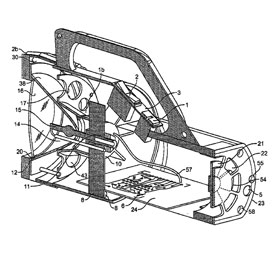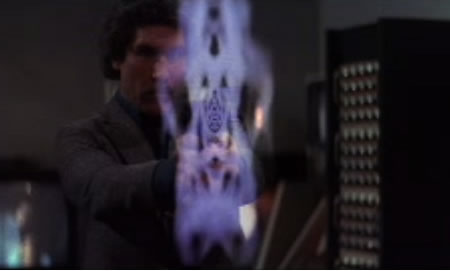Science Fiction
Dictionary
A B C D E F G H I J K L M N O P Q R S T U V W X Y Z
StunRay Paralyzes With Light

The StunRay from Genesis Illumination stops bad guys with a flash of high-intensity light. The device consists of a 75 watt lamp along with special optics that focus the light in a targeted beam.
The XL-2000 projects a controlled beam of white light more
than 10 times more intense than an aircraft landing light
and instantly adjustable from 1° to 10° beam width.
The projected light is bright enough to read a
newspaper a mile away.
The XL-2000 features StunRay® patented technology whereby the intense beam of incoherent light, flashed in an opponent’s eyes, disorients and incapacitates to allow time for capture & restraint. The subject fully recovers within 5 minutes and suffers no pain or lasting injury. Unlike most other non-lethal defenses, the XL-2000 is effective at ranges to 200 feet and allows for a measured escalation of response to any threat.

(StunRay)
“It’s the inverse of blindness—the technical term is a loss of contrast sensitivity,” says Todd Eisenberg, the engineer who invented the device. “The typical response is for the person to freeze. Law enforcement can easily walk up and apprehend [the suspect].”
Science fiction fans have been given a glimpse of this particular future. In his 1938 story Satellite Five, Arthur K. Barnes writes about a paralysis ray:
"I have invented a weapon, Miss Carlyle, that will render the monster on Satellite Five helpless!" he proclaimed dramatically. "A paralysis ray!" Gerry was dubious. She had seen abortive attempts at paralysis rays before."What's it's principle?" she asked.
"The transmission of a nerve impulse along the nerve fiber is provided by local electrical currents within the fiber itself... Passage over the junction point between cells is effected by a chemical transmitter, acetylcholine...
Lunde now exposed the interior of the leaden colored box... The interior showed a bewildering array of tubes and coils, all in miniature... The lens was shutterlike, similar to a camera lens...
"This, in effect," went on Professor Lunde in lecture style, "produces a neutron stream... And the penetrating neutron blast destroys the acetylcholine by adding to its atomic structure, thus making it so extremely unstable that it breaks itself up at once."
Fans may also recall the L.O.O.K.E.R. (Light Ocular-Oriented Kinetic Emotive Responses) from the 1981 movie Looker, written and directed by Michael Crichton. In the film, the L.O.O.K.E.R. is a light pulse device that can instantly mesmerize a person, causing them to lose all sense of time.

(L.O.O.K.E.R. (Light Ocular-Oriented Kinetic Emotive Responses))
From Genesis Illumination via SciAm; thanks so much to Winchell Chung for the tip and a reference.
Scroll down for more stories in the same category. (Story submitted 4/3/2011)
Follow this kind of news @Technovelgy.| Email | RSS | Blog It | Stumble | del.icio.us | Digg | Reddit |
Would
you like to contribute a story tip?
It's easy:
Get the URL of the story, and the related sf author, and add
it here.
Comment/Join discussion ( 0 )
Related News Stories - (" Weapon ")
Man Builds 200 Foot Basement Firing Range
'The basement was huge... carved deep into the rock.' - Clifford Simak, 1963.
Russians Create Robot Tank Platoons
'The remotely-operated robot tank is an old idea...'
Unmanned Boats Attack At Sea
'The autofreighter smashed into the boat...'
Iron Drone Raider Counter-UAV Operations
'You've got an aggressive machine up in the air now.' - Robert Sheckley, 1953.
Technovelgy (that's tech-novel-gee!) is devoted to the creative science inventions and ideas of sf authors. Look for the Invention Category that interests you, the Glossary, the Invention Timeline, or see what's New.
Science Fiction
Timeline
1600-1899
1900-1939
1940's 1950's
1960's 1970's
1980's 1990's
2000's 2010's
Current News
India Ponders Always-On Smartphone Location Tracking
'It is necessary... for your own protection.'
Amazon Will Send You Heinlein's Knockdown Cabin
'It's so light that you can set it up in five minutes by yourself...'
Is It Time To Forbid Human Driving?
'Heavy penalties... were to be applied to any one found driving manually-controlled machines.'
Replace The Smartphone With A Connected Edge Node For AI Inference
'Buy a Little Dingbat... electropen, wrist watch, pocketphone, pocket radio, billfold ... all in one.'
Artificial Skin For Robots Is Coming Right Along
'... an elastic, tinted material that had all the feel and appearance of human flesh and epidermis.'
Robot Guard Dog On Duty
I might also be thinking of K-9 from Doctor Who.
Wearable Artificial Fabric Muscles
'It is remarkable that the long leverages of their machines are in most cases actuated by a sort of sham musculature...'
BrainBridge Concept Transplant Of Human Head Proposed
'Briquet’s head seemed to think that to find and attach a new body to her head was as easy as to fit and sew a new dress.'
Google's Nano Banana Pro Presents Handwritten Math Solutions
'...copy was turned out in a charming and entirely feminine handwriting.'
Edible Meat-Like Fungus Like Barbara Hambly's Slunch?
'It was almost unheard of for slunch to spread that fast...'
Sunday Robotics 'Memo' Bot Has Unique Training Glove
'He then started hand movements of definite pattern...'
Woman Marries Computer, Vonnegut's Dream Comes True
'Men are made of protoplasm... Lasts forever.'
Natural Gait With Prosthetic Connected To Nervous System
'The leg was to function, in a way, as a servo-mechanism operated by Larry’s brain...'
Spidery 'Walk Me' Toyota Autonomous Wheel Chair Like Star Wars
Walk along with the emperor.
Dancing Robots Taught Dance Moves
'A clockwork figure would be the thing for you...'
Proof Of Robothood - Not A Person
'Who are you people? - Show 'em.'
